Search
[{{{type}}}] {{{reason}}}
{{/data.error.root_cause}}{{{_source.title}}} {{#_source.showPrice}} {{{_source.displayPrice}}} {{/_source.showPrice}}
{{#_source.showLink}} {{/_source.showLink}} {{#_source.showDate}}{{{_source.displayDate}}}
{{/_source.showDate}}{{{_source.description}}}
{{#_source.additionalInfo}}{{#_source.additionalFields}} {{#title}} {{{label}}}: {{{title}}} {{/title}} {{/_source.additionalFields}}
{{/_source.additionalInfo}}

Final Fantasy Mystic Quest
Developed By: Squaresoft
Released: October 5th, 1992
Available On: Super Nintendo
Genre: Role-playing game
ESRB Rating: E
Number of Players: 1
Price: $499.97 new, $12.40 used
Final Fantasy Mystic Quest was created by SquareSoft(now Square-Enix) as an attempt to get Western gamers into the JRPG genre. For the most part, it failed in what it was designed to do and Final Fantasy Mystic Quest is today regarded as at best a kid's game and at worst an embarrassment.
My personal opinion of the game is to enjoy it for what it is: A Final Fantasy game for beginners, or Final Fantasy meets Zelda. Don't come into this game looking for another Final Fantasy IV or Final Fantasy VI, or even another Final Fantasy I, and then you won't be disappointed. If you look at Mystic Quest on its own, without comparing it to the epics that are FF2/4 or FF3/6, you can have a fun time playing and enjoying an interesting storyline in a unique world.
You begin the game at the Hill of Destiny as Benjamin (although you can change his name to whatever you wish.) Your village has disappeared, and you run into a mysterious old man who tells you to slay a Behemoth. After this is accomplished, you are told your goal is to save the world and restore the four crystals: Earth, Water, Fire, and Wind. This helpful old man will become your guide along the way, showing up in places to give you hints. Your first mission? Save the Crystal of Earth.
Mystic Quest is a beginner's RPG for certain, but the first curve of the game aptly epitomizes what is known on TVTROPES.ORG as 'early game Hell.' While are you saving the Crystal of Earth, you can die very easily in battlefields and in dungeon areas. Worse, you are either by yourself, or only have one person join your party, which is the mechanic for the whole game. Yep, you are either doing it alone or have one partner. Almost always, the partner will be much more overleveled than you are, and while you can gain levels, they cannot.
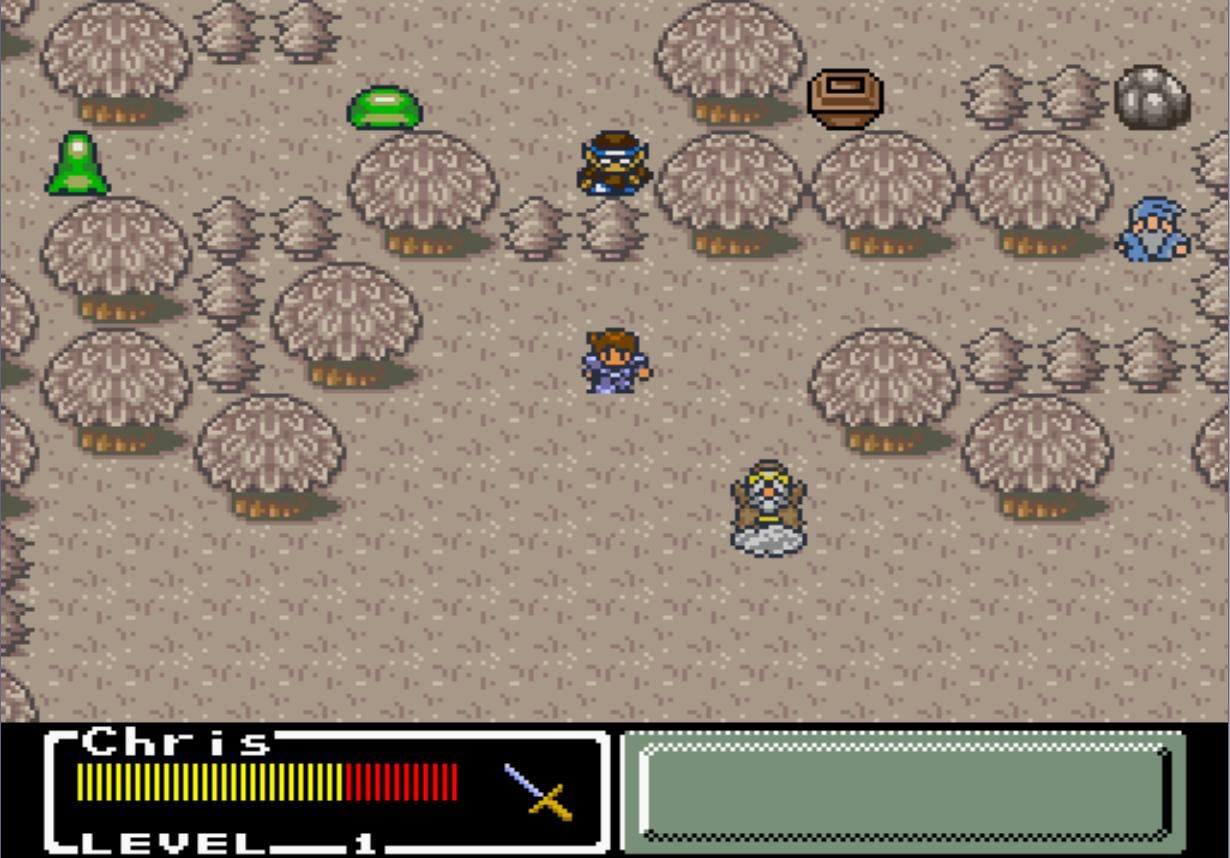
Strong Points: Enjoyable as a stand-alone game; amazing music; cute characters
Weak Points: Too easy at times; no overworld exploration
Moral Warnings: Fantasy magic
As the game progresses, you are introduced to several other characters. The first, Kaeli, joins you in Foresta, and gives you the Axe weapon. In this game, you retrieve weapons either when characters leave your party, or you can find them in chests. Unlike other FF games, there are no shops to buy treasure in, and you can't sell old armor and weapons- the game updates it for you automatically. On the plus side, you are upgraded to the more powerful armor. With weapons, you keep them all, and you can pick and choose for the main character (the other character will use what they join your party with.) and you get quite a variety of weapons here- bombs, a sword, an axe, and a claw. The claw is the most interesting, and its final form, the Dragon Claws, acts a lot like the Hookshot from Zelda. You can throw bombs too. See? Final Fantasy meets Zelda. Another unique feature of this game is you can jump.
The battlefield and overworld mechanics are where the flaw of this game comes in. On the plus side, you can see the enemies, so you aren't spammed by random encounters every 2 seconds. Also, the monsters change appearance as they weaken, which is handy. You can either put your 2nd character on autobattle or on manual, but the former has just as many disadvantages as advantages. Battles are mostly easy, but if your characters are paralyzed or petrified, and you only have 2 of them, it's an instant game over. However you can restart in the battle, so continuing is a slap on the wrist, if that. Some battles cannot be skipped, such as bosses. The only really hard ones that you might die at though are Flamerus Rex, at the start of the game, or the final boss, the Dark King.
The overworld mechanics are where this game really dropped the ball. I believe had it been a free-roaming overworld you could explore, this game would be infinitely more popular. Instead, you can only go in one of the directions the arrow points at. You can't freely explore the Overworld. Yep. That's about it.
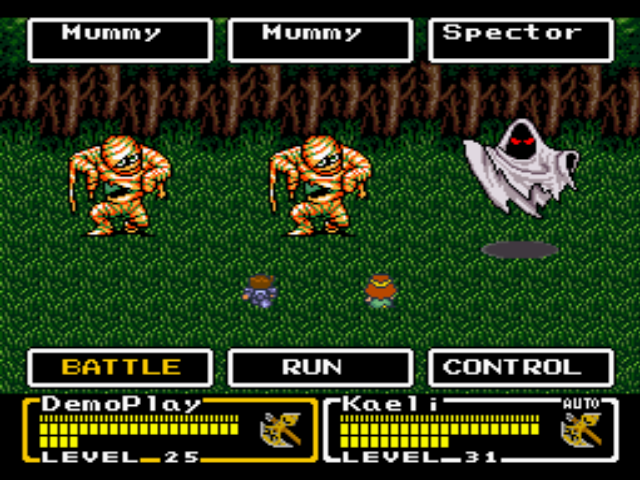
Higher is better
(10/10 is perfect)
Game Score - 80%
Gameplay - 17/20
Graphics - 7/10
Sound - 8/10
Stability - 4/5
Controls 4/5
Morality Score - 84%
Violence – 6.5/10
Language - 10/10
Sexual Content – 10/10
Occult/Supernatural – 6.5/10
Cultural/Moral/Ethical - 10/10
Now, for the place this game really shines- THE MUSIC. Even those who hate this game admit the music is amazing, and they are right. From the title screen to the ending credits, there are no tunes I hate in this game. Amazing tracks include all battle themes, especially the regular battle theme, Fireburg, Focus Tower, Pazuzu's Tower, Bone Dungeon, Doom Castle, and Lava Dome/Volcano. I still have my CD of this game from back in the day when you bought them on eBay before YouTube, and I'm not ashamed to admit it sometimes plays when I'm driving.
A little bit about the characters: Benjamin talks a lot more than Cloud or Squall, and has a pretty engaging personality. His shrug when something unexplainable happens is cute, and will happen quite a lot. The female characters are incredibly strong women, especially for a beginner game. Kaeli joins your party and fights in spite of her poor health later, and Phoebe joins your party in a search for her grandpa and to save her town. Tristam is a bit of a jerk, always teasing Benjamin, but he is very helpful in the first dungeon. Reuben is my favorite of the male characters- you find him in Fireburg and he is pretty upbeat and mellow. All of them somewhat fit a stock RPG role- Benjamin is the knight, Kaeli is the white mage/healer, Tristam is the ninja/Thief, Reuben is a jack of all trades, and Phoebe is a red mage/archer.
Morally how does the game stand up? Well, there's magic. You learn magic from spell books too, as opposed to other Final Fantasy games where you just learn them naturally, or buy tomes, as in Final Fantasy II Japan, or from Materia or items or Espers. But this is really all there is to be concerned about. There's nothing sexual or overly violent in the game. No alcohol references, and the female characters wear appropriate clothing- they wear Greek like tunic-dresses that cover their torso and legs, and bare their arms, but only the most prudish of people would be angry at arms showing. I would feel comfortable letting even a very young child play it.
Overall, I like this game, but I understand why it is resented as a whole in the Final Fantasy fandom. It's a game you can enjoy for a day or so, but there's little replay value. Some fans have made fanmade versions to beef up the difficulty, but I have not played any of these. From a Christian perspective, I see little to be concerned about. From a secular perspective, it is what it is. It's a game for beginners. I found it to be a good filler between FF4 and FF6 back in the day. But I still agree that we should have gotten Final Fantasy V instead of having to wait for FF Anthology. A good used copy is a good use of money; no need to buy it new though.
- Details
- Category: SNES
- By Daniel Cullen
- Hits: 6294

Shin Megami Tensei 2
Developed By: Atlus Co., Ltd.
Published By: Atlus Co., Ltd.
Released: Apr 18, 1994
Available On: SNES
Genre: Turn-based Role Playing Game
ESRB Rating: None specified (would be rated Mature by contemporary ERSB standards)
Number of Players: Singleplayer
Price: $100.00+ (new) $11.00+ (used)
Note: Only the SNES version is covered since it can be played legally in English, provided you legitimately own a copy of the original Japanese ROM and patch it manually into English via a fan translation. All other versions and ports like the PSX and GBA ports will not be addressed in this review.
When Atlus released the first Shin Megami Tensei, they had every intention of following its events up with a sequel. Given the first game had three endings, they had to pick one and build on it. In terms of gameplay, they also had to take what was good about the first and make it even better. Whether they succeeded or not will be the topic of this review.
The story follows from the Neutral ending of the first SMT, where the hero defeated the faction leaders of both Law (Messian) and Chaos (Gaian). The survivors of both factions, now forced to live in the Great Cathedral, one of the few places that survived the flood that overwhelmed Tokyo towards the close of the first game, initially attempted to make the most of their situation.
As the water receded, they continued to build upon the foundations of the Great Cathedral, turning it into a massive towering arcology that became known as the Tokyo Millenium. In the process, the Messians seized power, forced the Gaians underground, and established a theocratic regime under the rule of God, controlled by a council of elders at the apex of the Tokyo Millienum called "The Center".
The Center prophesied a Messiah would come to deliver them all to a better world, one where, despite their efforts, attacks by demons were a constant threat. However, God seemingly proved silent on what to do next, so the Elders decided to take matters into their own hands.
Not long after, an amnesiac gladiator fighter named Hawk soon discovers he was the result of this plan, a plan to provide the Messiah God had promised. He soon discovers not only his true name and past but also that the Center is riddled with corruption. As he is forced to take a stand against that corruption, he also discovers both Lucifer and God are manipulating events in the background, and soon the man created as the Messiah must choose to either follow the will of God, Lucifer, or neither to save humanity from a fate even worse than the nuclear fires that had ushered about the apocalypse in the previous game.
The gameplay is essentially identical to the original game, with first-person 3D dungeons and a top-down overworld map. However, it has undergone several improvements, such as simplified menus, a much more accessible minimap feature to avoid getting lost (and that has been improved to show the direction you are facing to make navigation less painful). Demon negotiations and summoning return, as do sword fusions. There is now a new feature called "fusion accidents" where you can get a random demon as opposed to the one you expected to get at random intervals, which is affected by the moon phase mechanic that also returns from the previous game (which again affects certain treasures and demon negotiation success). Demons can now "inherit" skills from prior fusions, which provides more flexibility for retaining effective teams with well-rounded abilities.
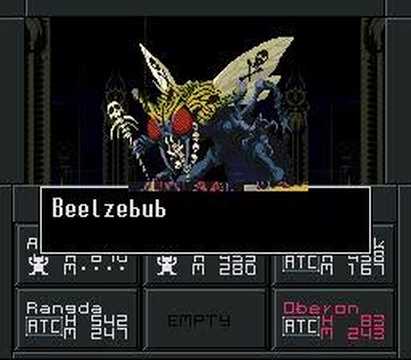
Strong Points: Improved storyline from predecessor; refined gameplay mechanics
Weak Points: Some game-breaking bugs
Moral Warnings: RPG level violence; Some adult language and some crude sexual dialogue; some highly sexualized monster designs; blatant occult references and multiple mythological references alongside explicit Christian ones (some presented in a very negative way); negative portrayals of what amounts to Christians and God, with unavoidable opposition to both (including rampant blasphemy depending on player choices); references to gambling and alcohol, with player ability to do both activities if they choose
Graphics retain many of the samey dungeon designs, but there is now a more colorful and vibrant look to offset the dreary and sterile post-apocalypse/cyberpunk motif. Demons have much more detail in this game and even some decent degree of animation. Monochrome colors are still quite prevalent in 3-D dungeon areas, but at least they have more texturing and details. By 1994 standards, it was a decent improvement on the first game, though it still may seem dated to modern players in terms of area palettes.
Sound is somewhat improved, with many cyberpunk and techno themes like in the first game alongside many themes appropriate to the factions. Sound effects are slightly more varied than the previous title, not to mention sound more crisp and distinct. Controls are largely the same as in the preceding game save some ergonomic improvements like easier to navigate menus.
Stability is both better and worse than in SMT I. While it's somewhat harder to trigger game-breaking bugs that can mess up character alignment so you are locked into one alignment on another path, it's still possible to do so via some sequence breaking glitches. Some other bugs are somewhat beneficial, like random drops from certain early game enemies giving you powerful end game level equipment, though purposely trying to trigger them can corrupt save files as well.
On the moral side of things, while inheriting many of the moral problems that plagued its preceding game it also has it's own specific moral concerns.
Violence is of the RPG level and language is no worse than a movie fit for nighttime viewing most of the time, and while there is some mild sexual innuendo (you have some female party members who will get sexually proposed in a mild fashion that is played for laughs in some demon negotiations), the game is otherwise no worse than it's predecessor in this regard. There are some references to gambling and getting drunk scattered about, but they are pretty minor in the grand scheme of things, but common enough early on to be worth noting as a concern.
However, in terms of sexual depiction, the game does feature some more sexually detailed demons. One looks like a talking green male private part riding a golden chariot (meant to partially embody the Buddhist take on the sin of lust, and partially based on a Japanese wordplay pun). Some demons have exposed female breasts (mostly those based on mythological beings associated with fertility, though in one bizarre example a male being is depicted with these as part of their incredibly off-putting design which looks freakish in general). This aside, there are no other serious red flags save one demon based on Aleister Crowley who makes references to wanting to perform an orgy (a reference to the real Crowley and his own historically infamous hedonism).
As for the occult and supernatural, Chaos returns in all its pagan trappings, complete with hexagrams and occult imagery, though Law is not much better. While they aren't prone towards such evil imagery, some of the more depraved representatives of Law are not above using demons to do their dirty work or act not much better or even worse than said demons despite their alleged alignment to the Will of God. There is also the standard demon negotiation and summoning, though given the player is supposed to basically be a serial numbers filed off Jesus clone, the fact you can convince demons to be subject to your orders makes a bizarre sort of biblical sense. Regardless, the circumstances and depiction are still quite morally dark grey at absolute best.
It's on this note we need to address a major concern, one the developers had to make clear in interviews: While God (aka YHVH) is the final boss (even in the Law ending), he is NOT the actual God. He's more a corrupt parody based on a warped perception of his true nature since human belief influences how the supernatural manifests in the SMT universe. For Christians worried they are committing the ultimate blasphemy, despite all the trappings of the Abrahamic deity YHVH is styled after, he's a twisted (and mortal) avatar borne of human misinterpretation of his true nature. For all in-universe intents and purposes, he's regarded as the real deal by his subordinates and enemies because they too have been altered by human perception to see YHVH as the true face of God, not the demented parody he is.
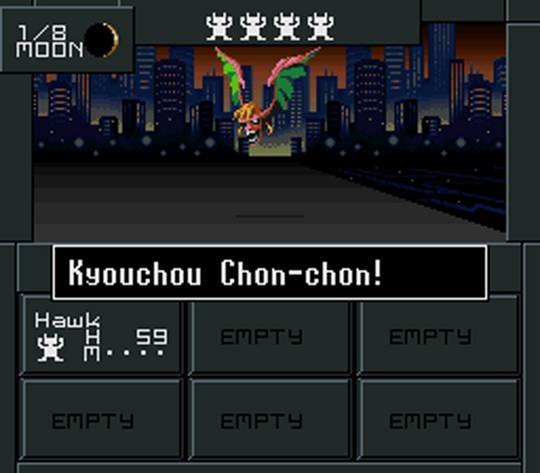
Higher is better
(10/10 is perfect)
Game Score - 74%
Gameplay - 16/20
Graphics - 7/10
Sound - 7/10
Stability - 3/5
Controls - 4/5
Morality Score - 29%
Violence - 5/10
Language - 3/10
Sexual Content - 4/10
Occult/Supernatural - 2.5/10
Cultural/Moral/Ethical - 0/10
With that in mind, the endings all have some ethical concerns no matter what your morals are:
The Neutral ending involves striking down both Lucifer and YHVH and amounts to committing deicide as opposed to giving humanity anything to believe in, and while a Christian may not lose sleep over Lucifer's defeat, YHVH does form a huge core of the reason most people in-universe have any sort of hope, taking him out (corrupt and twisted as he may be) in favor of no higher power deciding man's fate will likely be unsettling at best.
Chaos involves siding with Lucifer, and while Lucifer comes off as much less morally grey in this game than he does in the prequel (though his motives are just as ideologically opposed to Law), a Christian will certainly be repulsed by the idea of teaming up with Lucifer to deliberately rebel against a God-like figure (even if the stand-in is a twisted, demented parody of the real deal).
Even Law will be disturbing, because while that ending is based on holding YHVH to the same covenant the real God held people to (and you team up with Satan [a distinct being from Lucifer], who fulfills his Jewish role as God's Accuser to call YHVH out on breaking said covenant). While this does follow the basic concepts of Judeo-Christian thought that God's covenant with mankind is bilateral and that neither can cheat on its provisions, you are still judging who amounts to be GOD and trying to strike them down in the process.
All gameplay paths cover extensively the corruption and hypocrisy those who claim to be following the Law may fall prey to; Christians may find their criticisms of those who do not practice what they preach (a recurrent plot element) to be quite disturbing. The game goes into graphic detail the kinds of depravity (including slavery, mind control, and genocide, among other horrors) those who believe themselves just will commit when they believe none of their actions are hypocritical and even righteous. By the same token, no feelings are spared in showing the dark side of spiritual hypocrisy humanity can fall prey to.
Another related but different moral and ethical concern is the fact your main character is a Jesus clone. The game is very careful to never outright say this about your character (closest they get is Satan alluding to Jesus' mother at one point in an indirect reference to you), but the implications are very obvious for anyone with a passing knowledge of the New Testament. Further, given your main character may choose in-universe moral choices that are based on the Law/Neutral/Chaos alignments and some of the choices are quite ethically grey regardless, it could definitely unsettle a Christian to play as a Jesus clone who can, if they choose, act in a manner Christ would NOT act like.
As a game, Shin Megami Tensei 2 is a definite improvement over its predecessor in every regard, and while still plagued with some stability issues, deserves to be considered a classic whose appeal is worthy of any serious role-playing fan. Morally, this game dares to examine Law and all it's dark sides as well as all its virtues, and Christians are going to be made uncomfortable for sure over how it presents this. Even those who simply align with the philosophy of Law, in general, will be wary as this game is themed around Law with no sugarcoating its excesses and flaws. The other content mentioned like the violence, occult themes, sexual depictions, and other material will not make anyone already unnerved by the above any more comfortable, and no matter what you believe; even if you take into account the word of the developers, you still will have to fight a God-like being at some point, there is no avoiding it. Neutrality and Chaos are given somewhat less focus, but one focuses on the reverse of Law, and the other leans in the direction of denying any obeisance to a higher power, and the latter is likely to be disturbing in particular to anyone of any faith, not just Christianity. The former is also somewhat glossed over and it's negatives are not dwelled on. Considering Chaos is advocated by Lucifer, this is not a good thing for Christians in particular especially since it's key pillar is utter defiance of even the good aspects of God's law.
In essence, it's better than the first game in terms of gameplay but still retains many things that were bad about it, and morally, it asks a lot of uncomfortable moral questions and presents a lot of material certain to make anyone who believes in God cringe at best, but if you are a mature adult who likes good RPGs and is reasonably secure in your faith and/or are not troubled by such questions and ideas being posed to you, then this game is certainly worth playing and beating at least once.
- Details
- Category: SNES
- By Daniel Cullen
- Hits: 6967

Shin Megami Tensei
Developed By: Atlus
Published By: Atlus
Released: October 31, 1992
Available On: iOS, SNES
Genre: Turn-Based JRPG
ESRB Rating: Teen (iOS version rated for this, SNES version nominally Mature)
Number of Players: Singleplayer
Price: $27.99 (SNES version) $5.99 (Apple iOS version)
Note: This mainly concerns the SNES (fan translation patch to English from original Japanese, must own a legitimate copy of the original game to use the patch) and iOS versions (official English translation by Atlus, only playable via certain emulators and older phones currently). Content from other Japan-only ports like the PSX, Sega CD and PC Engine versions (unavailable via any legal means in English at this time) will not be covered.
When people discuss religion, questions of ethics and philosophy naturally stem from said discussions, as many ethics and philosophical positions have originated from religions. However, that doesn't usually make for an interesting video game experience, but Atlus decided to go against the grain and try with the 1992 release of Shin Megami Tensei.
Before we continue, some background. Shin (meaning "True" in Japanese) Megami Tensei is a semi-reboot of the Japanese Megami Tensei series for the NES, which themselves were based on a sci-fi novel series called Digital Devil Story by Aya Nishitani. The "Megami Tensei" part of the title refers to the "Resurrection of the Goddess", a reference to Japanese mythology and it's key goddess figure Izanami, which was a plot point of the original novels. The SMT series (also available in Japan for its early games for the most part) tells it's own story, merely reusing some themes (though some elements directly related to the source still make some cameos), so the title is a bit of an artifact not very indicative of its own story and gameplay.
The story is as follows. In 19XX, while checking your email, some mysterious man named Steven sent you and everyone he could find an email with something called the "Demon Summoning Program", and included a dire warning that someone had broken down the barriers of the natural and supernatural worlds. The first half of the game involves seeing his warnings come true and ends with the world being destroyed in nuclear fire despite your best attempts to stop the forces of Law and Chaos from destroying everyone caught in the middle.
The second half of the story resumes after the apocalypse, where humanity is split into factions, and you must choose whether you will align with Law, Neutrality, or Chaos, all of which are manipulated and led by demons of various religions and myths, and the dramatic finale takes place at one of the few bastions of civilization left (after what amounts to a replay of the Great Flood of Genesis), where you must decide what ideology you will side with while the forces of Law (led by the highest orders of angels in service to God) and Chaos (led by Lucifer) vie for your allegiance.
The gameplay is quite similar to first-person computer RPGs like Wizardry, utilizing 3D style dungeons and a top-down overworld map. Combat involves using melee, ranged (guns), and magical attacks, and both humans and demons can be party members.
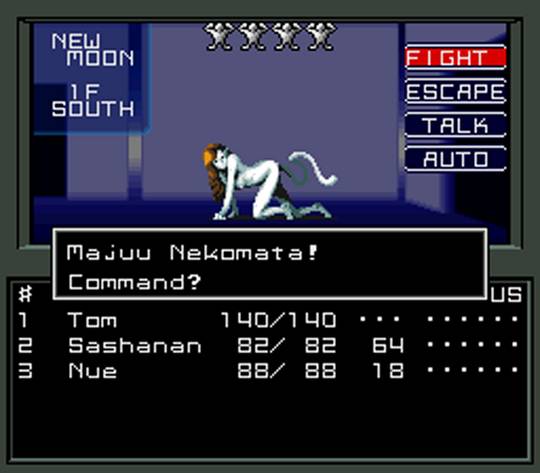
Strong Points: Interesting monster summon and control mechanics; interesting story discussing themes of ethics and philosophy
Weak Points: Some game-breaking bugs; tedious menu-based controls; repetitive music; some game mechanics poorly explained and fleshed out
Moral Warnings: Occult and demon summoning references as explicit plot points and gameplay mechanics; some RPG based violence and unavoidable scenes of murder; moderately strong language used by all characters throughout; option to directly oppose God and a faction that is Christian-like in many respects; many ethically questionable decisions available to the player; some sexual content depicted in monster designs; frequent usage of religions and mythology in a crossover context that would be considered blasphemous
Predating Pokemon, the game allows negotiating with demons to get them to join your party as opposed to fighting them, and you can also combine them in summoning chambers to create more powerful demons. Demons are used as a generic term for everything in the game (even humans count and are treated as such if recruited) that can be ally or enemy. Depending on the choices you make through the game, some demons will be more inclined to join or reject you depending on your alignment to Law, Neutrality, or Chaos.
Eventually, there is a point where your alignment is locked into one of the three ideologies, and this will affect the final bosses you encounter and certain rewards specific to siding with one of three ideologies as well as giving one of three endings, where representatives of each ideology congratulate you on making your choice for good or ill. There are also some more minor gameplay features. Maps and combat feature a "moon phase", which will affect certain treasures and chances to successfully negotiate with certain demons. Another feature, which would get expanded in the sequel, is sword fusion, where one can infuse a sword with a demon and get a more powerful weapon from it, some of which are only usable if you have a certain alignment.
Graphics are, by 1992 standards, adequate. All demons are well designed, albeit some are palette swaps of each other with minor changes. Dungeons tend towards a monochrome look due to limited palettes, and exploration can be boring and difficult due to little variation in theme aside from wall colors in many of them.
Controls are a mix of first-person RPG controls in dungeons and combat and top-down controls in the overworld. Both function reasonably well, though there are a lot of menus to wade through. Sound is good if limited, with many iconic if repetitive techno/cyberpunk style themes mixed in with many themes appropriate to the factions (the Law theme has a cathedral music motif, appropriate given its leaders for example), and sound effects are adequate but little more than that.
Stability is another story. While otherwise completely playable from beginning to end, the alignment system (stored as a variable in the game engine) can get buggy if the player tries to sequence break certain story points, which can break the game, such as leaving the player locked into one alignment ending while their alignment is locked into something different.
Given this is a game around demon summoning, use of religions for discussing moral and ethical positions, and general occult and magical themes, it has a lot of moral concerns that require discussing in detail.
Violence in-game is rather sterile and RPG like in combat, but several murders do occur and are described in enough detail there is no mistaking what has happened. Sexual content is somewhat prevalent, and some demon design feature nudity and at least one attempts to seduce you at more than one point in the story. The SNES and iOS releases, however, do censor even more explicit details in this regard to be found in other Japan-only releases like the Sega CD and PC Engine versions, as no explicit nudity is present in these scenes. Language is somewhat crass and some mild sexual innuendo is present, and the religious will certainly be offended by certain characters who blaspheme God. There are references to the occult alongside explicit demon worship, services you can partake in if you are so inclined.
The ethical and moral need to be elaborated on, as the game takes one of three positions: Law is associated with monotheistic religions like Judaism and Christianity (and their serial numbers filed off adherents called Messians) and concerns a desire for order and a willingness to sacrifice free will. Neutrality concerns a desire for a choice between the extremes of Law and Chaos and is represented by Taoism and other esoteric faiths that fall between the Law and Chaos extremes. Chaos is represented by enemies of Law such as Lucifer, who leads an alliance of polytheistic faiths, fallen angels, and other classic opponents of monotheism (and their human adherents are collectively called Gaians). Chaos is primarily concerned with absolute free will, which leads to a world where no one is master over another and is a world based on personal strength for good or ill.
None of the three are presented as absolutely good or evil; all sides have arguments they can make for their sides. The player can, until the point of decision, work for or against whatever side they please; whatever questionable ethics they choose to show are their choice. After the alignment lock, they must work for the side they have chosen, and if on the Law or Chaos side, all demons explicitly aligned with the opposing side are barred from recruitment and will not work with you if summoned.
Further, the story is a crossover cosmology. While Law is primarily associated with Judaism and Christianity, it occasionally strikes alliances with Law inclined beings from other faiths. Chaos does the same thing from the other perspective, and according to the developers, human belief shapes the power and perception of the supernatural, hence the presentation of the supernatural in the story.
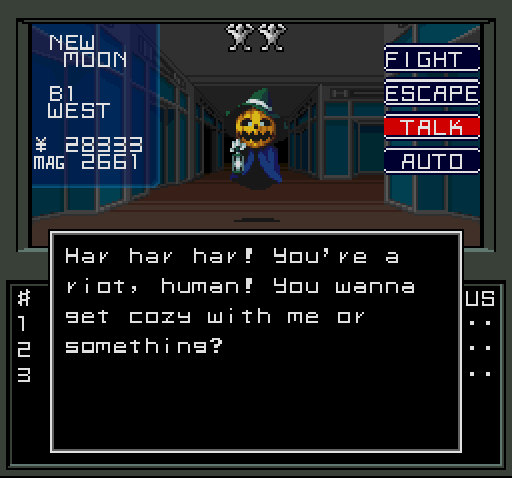
Higher is better
(10/10 is perfect)
Game Score - 70%
Gameplay - 16/20
Graphics - 6/10
Sound - 6/10
Stability - 3/5
Controls - 4/5
Morality Score - 24%
Violence - 5/10
Language - 3/10
Sexual Content - 4/10
Occult/Supernatural - 0/10
Cultural/Moral/Ethical - 0/10
While the above is certainly bound to offend depending on your religious principles, God is certainly implied (if not shown in this game, his seraphim act as agents of His Will) to be devoid of his more reasonable and compassionate traits, with his side being rather fanatical. Chaos is not much better, with Lucifer making no secret his world design is one of the strong trumping the weak and any semblance of order trampled into nothingness, so while the ethics of the Law and Chaos sides may have their virtues, neither of their leaders come off as overly sympathetic. Neutrality even has issues, as it involves what amounts to genocide of the leaders of Law and Chaos, basically declaring one will side with neither Law or Chaos' extreme views via omnicide. While it's the canon ending used for the next game, it is a morally checkered choice that isn't much better than siding with Lucifer, even if you are a Christian. Even Law may be offensive, as you are imposing God's Will via force instead of choice, which is certain to offend Christians who do not support the forcible imposition of theocracy.
The creators have again gone on record in interviews that they take no particular sides, religions were used as a backdrop to explore the extremes in the Law/Neutral/Chaos philosophies. The final decision as to what is right is for the player to decide for themselves, though, again, the manner in which they did this will certainly offend anyone of faith in some manner, given how there is precious little ground for a non-extreme view of any of the material they presented in the story.
Overall, as a game, it has an interesting story with a mix of science fiction meets fantasy that dares to make the player ask themselves questions of ethics in the process. It also has the gameplay that Pokemon would later refine further that requires strategy and foresight for getting the different endings in the long term.
On the moral side, this game is bound to be controversial to Christians at best, as well as adherents to many other faiths, especially given the fantasy kitchen sink where all religions and myths are presumed true, and the summoning of demons, occult imagery, and the choice to directly oppose God will certainly offend Christians, though working for him is also presented as a somewhat negative choice unless you don't mind imposing His Will via force as opposed to choice.
It's a timeless classic that set a bar future games in the SMT series would meet, improve on, and excel in terms of gameplay. However, if the presentation of morals is remotely offensive to you, and as a Christian, they nigh likely will be, then steer clear of this title, especially if you're not an adult capable of handling mature themes of this nature.







